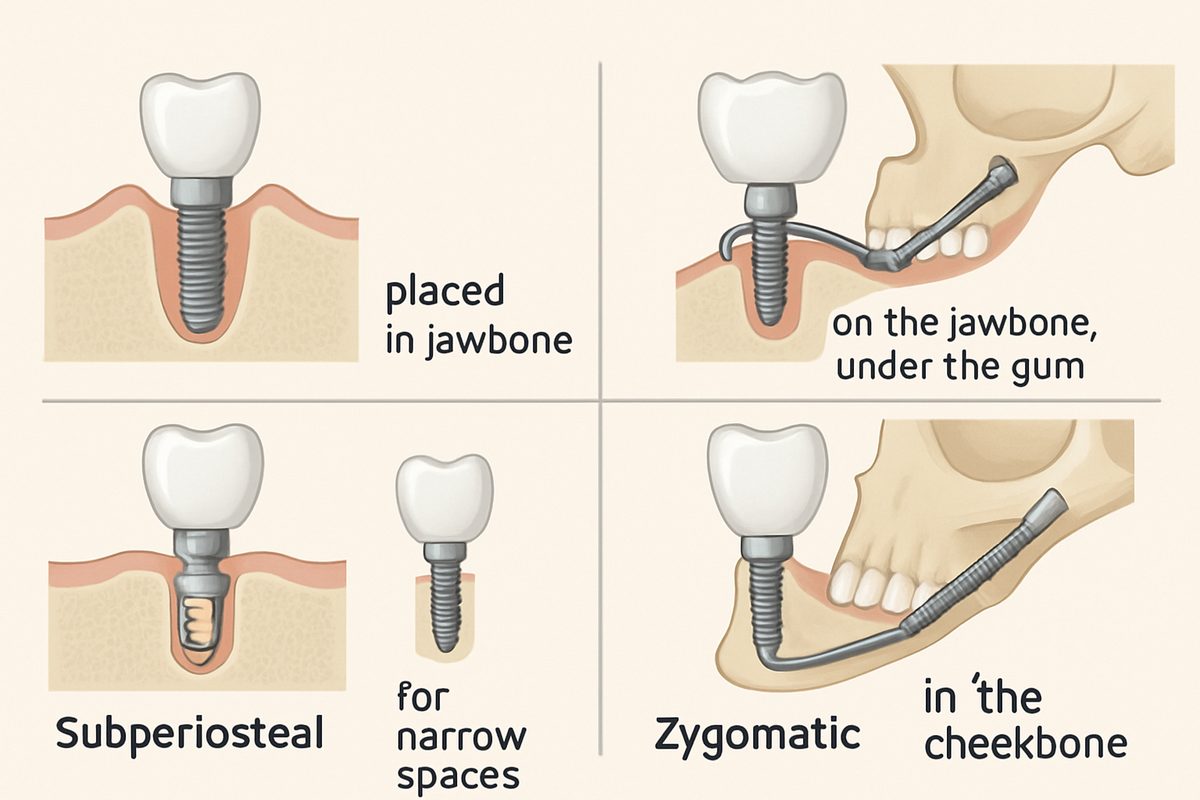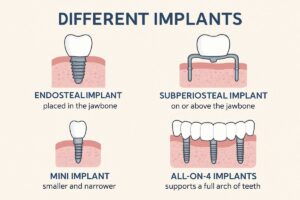Choosing the right type of implant matters for comfort, function, and long-term oral health. This guide explains what “type of implant” means and why the best choice for you in Montana depends on bone, overall health, and how many teeth you need replaced. Read on to compare options and learn practical next steps for Montana patients.
Overview: What “type of implant” means for Montana patients
A “type of implant” refers to the design and placement method dentists use to replace missing teeth. Options range from the common screw-shaped implant placed in the jaw to special designs for low bone or full-arch replacement. For Montana patients, factors like bone quality, the location of missing teeth, health conditions, and lifestyle shape the best type of implant in Montana for each person.
Common types of implants you’ll see in Montana
Endosteal implants — the standard type of implant in Montana
Endosteal implants are the most common type of implant. They are titanium screws placed directly into the jawbone. These work well for single teeth or several teeth with individual implants or bridges. Pros: high success rate, natural feel, long lifespan. Cons: need enough bone and a healing period before the final tooth is attached.
Subperiosteal implants — when bone is low
Subperiosteal implants sit on top of the jawbone under the gum using a metal frame. They are considered when jawbone height is low and a patient wants to avoid extensive grafting. Pros: option when bone is limited. Cons: less common today, may have more maintenance and a different long-term outlook than endosteal implants.
Mini implants — a lower-cost, temporary type of implant
Mini implants are smaller-diameter implants often used to stabilize dentures or fit narrow spaces. They are less invasive and cheaper, but usually not as durable for heavy chewing long term. Pros: quick, lower cost, useful for denture retention. Cons: shorter lifespan and limited use for larger restorations.
Zygomatic implants and full-arch solutions (All‑on‑4)
Zygomatic implants anchor into the cheekbone and are used for severe upper jaw bone loss. All‑on‑4 is a full-arch solution using four implants to support a fixed prosthesis. These options let patients avoid long grafting procedures and get stable, full-arch teeth more quickly. Trade-offs include more complex surgery and specialized planning.
Who is a good candidate for each type of implant in Montana?
Key factors that guide the choice of type of implant in Montana include:
- Bone volume and density
- Number and location of missing teeth
- Medical history (diabetes, immune issues)
- Smoking or other habits that affect healing
- Budget and time for treatment
Quick examples:
- Single missing molar → usually an endosteal type of implant
- Multiple missing front teeth with good bone → endosteal implants plus crowns or bridges
- Severe upper jaw bone loss → zygomatic implants or grafting with endosteal implants
- Loose dentures and limited budget → mini implants for denture stabilization
How digital technology helps pick the right type of implant in Montana
Modern tools make choosing the best type of implant in Montana more accurate. CBCT imaging shows 3D bone anatomy and nerve locations. Digital implant planning software lets dentists map ideal implant positions. In-house 3D printing produces surgical guides that translate the plan into precise placement. CAD‑CAM systems create well-fitting crowns and prosthetics. Together, these tools reduce surprises and improve outcomes.
What to expect during treatment for your chosen type of implant
Treatment steps are similar across implant types, with some differences for complex cases:
- Consultation and CBCT scan
- Digital planning and discussion of the best type of implant in Montana for your case
- Possible bone grafting if needed
- Guided surgery using printed guides or specialized techniques
- Healing and osseointegration (weeks to months)
- Final crown, bridge, or fixed prosthesis placed
Sedation options are available to keep you comfortable—from local anesthesia to oral or IV sedation—depending on the procedure. What to expect.
Why consider Flathead Dental Implant Arts and Dr. Dave Dodrill
Flathead Dental Implant Arts in Kalispell offers advanced digital workflows that help determine the best type of implant for each patient. Dr. Dave Dodrill, DDS (cum laude), completed advanced training and leads the practice’s implant care. The office uses CBCT imaging, in‑house 3D printing, guided-surgery workflows, and CAD‑CAM prosthetics to streamline treatment. Dr. Dodrill pairs technical skill with a compassionate approach and community-focused care.
Next steps: Choosing the right type of implant in Montana
If you’re ready to learn which type of implant in Montana fits your needs, book a consult with CBCT imaging. Prepare questions about bone needs, recovery time, costs, and sedation. For a personalized evaluation, schedule an appointment at Flathead Dental Implant Arts in Kalispell to review your options and create a clear treatment plan.




